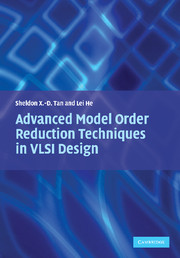Book contents
- Frontmatter
- Contents
- Figures
- Tables
- Foreword
- Acknowledgments
- 1 Introduction
- 2 Projection-based model order reduction algorithms
- 3 Truncated balanced realization methods for MOR
- 4 Passive balanced truncation of linear systems in descriptor form
- 5 Passive hierarchical model order reduction
- 6 Terminal reduction of linear dynamic circuits
- 7 Vector-potential equivalent circuit for inductance modeling
- 8 Structure-preserving model order reduction
- 9 Block structure-preserving reduction for RLCK circuits
- 10 Model optimization and passivity enforcement
- 11 General multi-port circuit realization
- 12 Reduction for multi-terminal interconnect circuits
- 13 Passive modeling by signal waveform shaping
- References
- Index
2 - Projection-based model order reduction algorithms
Published online by Cambridge University Press: 19 January 2010
- Frontmatter
- Contents
- Figures
- Tables
- Foreword
- Acknowledgments
- 1 Introduction
- 2 Projection-based model order reduction algorithms
- 3 Truncated balanced realization methods for MOR
- 4 Passive balanced truncation of linear systems in descriptor form
- 5 Passive hierarchical model order reduction
- 6 Terminal reduction of linear dynamic circuits
- 7 Vector-potential equivalent circuit for inductance modeling
- 8 Structure-preserving model order reduction
- 9 Block structure-preserving reduction for RLCK circuits
- 10 Model optimization and passivity enforcement
- 11 General multi-port circuit realization
- 12 Reduction for multi-terminal interconnect circuits
- 13 Passive modeling by signal waveform shaping
- References
- Index
Summary
Compact modeling of passive RLC interconnect networks has been an intensive research area in the past decade owing to increasing signal integrity effects and interconnect-dominant delay in current system-on-a-chip (SoC) design [72].
In this chapter, we briefly review the existing modeling order reduction (MOR) algorithms for linear time-invariance (LTI) systems developed over the past two decades in the electrical computer-aided design community. Since compact modeling of TLI systems is a well researched and studied field, many efficient approaches have been proposed over the years. Given the space in this book, we cannot review all of them and neither do we attempt to be complete in our review. Instead, we mainly review the Krylov subspace projection-based model order reduction methods, which are widely used MOR methods and are closely related to the rest of this book. Although there exists an excellent and detailed treatment of Krylov subspace projection-based methods already [14], for the completeness of this book, we still present some basic concepts, algorithms and important results for Krylov subspace projection-based MOR methods. We try to present them in a way that can be easily understood from the practical application point of view.
Moments and moment-matching methods
In this section, we briefly review the concepts of time-domain moments, the Elmore delay and Pade-approximation-based moment-matching method, which are important concepts for subspace projection-based model order reduction methods.
- Type
- Chapter
- Information
- Publisher: Cambridge University PressPrint publication year: 2007

